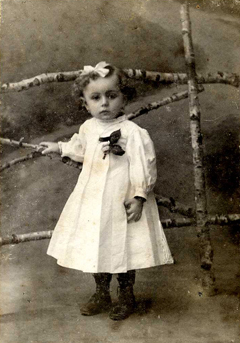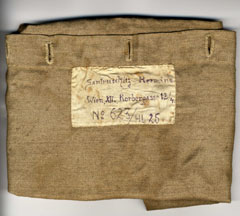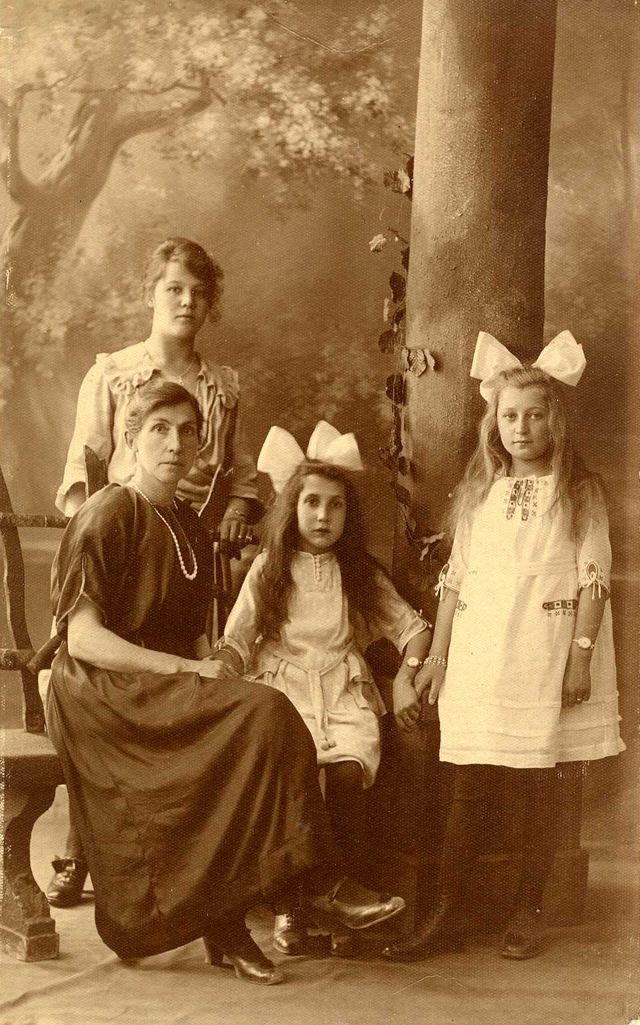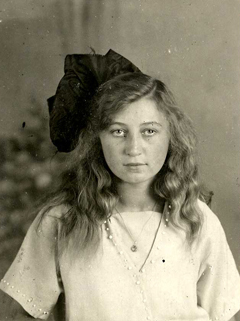
Oldest photograph of Miep Gies, ca. 1912 in ViennaOn 15 February 1909, Miep Gies was born into a working class family in Vienna, as Hermine Santruschitz (later spelt in the Netherlands as Santrouschitz). She was five years old when the First World War broke out. At first she thought all the soldiers in the streets were rather exciting. However, father and mother Santruschitz could barely make ends meet, both during and after the war. The serious food scarcity had a grave impact, and after their second daughter was born in 1919, there was even less food to go around. Hermine wasn't a strong child to begin with, and due to the lack of food she became undernourished and was often unwell. ‘I was a small child to begin with, and seemed to be wasting away, rather than growing normally. My legs were sticks dominated by bony kneecaps. My teeth were soft. When I was ten years ol, my parents had another child; another daughter. Now there was even less food for us all. My condition was worsening, and my parents were told that something had to be done or I would die.’
In the fall of 1920 she was suddenly thrown a lifeline: a Dutch workers' association had taken the initiative to set up and aid program for Austrian working class children. These children could come to the Netherlands for a number of months to regain their strength, and Hermine was one of the lucky ones, permitted to go along. On a cold winterday in December 1920, a train filled with weakened Viennese children departed for the unknown town of Leiden, in the unknown country of the Netherlands. ‘Although I was eleven, I looked much younger. My long, fine dark blond hair was held back with a large piece of cotton cloth tied into a big puffed bow. A card was hung around my neck. On it was printed a strange name, the name of people I had never met. The train was filled with many children like me, all with cards around their necks.’
The small rucksack that Miep brought when she traveled from Vienna to Leiden in December 1920. Click on the photo to enlarge. The train arrived in Leiden and the children were woken up and led into a large hall. Unfamiliar people tried to read the names on the tags, and Hermine was picked out by a 'not very big, but very strong-looking man'. 'I wasn't afraid and willingly went along with him'. The strong man's name was Laurens Nieuwenburg, and he was foreman at a coal company in Leiden. He brought Hermine to a small house just outside the town where he lived with his wife, four young sons and a daughter. The eldest boy spoke a few words of German and acted as interpreter. ‘Despite the language problem, all the children were kind to me. Kindness, in my depleted condition, was very important to me. It was medicine as much as the bread, the marmalade, the good Duch milk and butter an chees, the toasty temperature of the warm rooms. And, ahhh, the little chocolate flakes known as “hailstones” and other chocolate bits called “little mice” they taught me to put on thickly buttered bread-treats I’d never imagined before.'
Miep (on the right) around 12 years old, with foster mother in Leiden, around 1921.
The family Nieuwenburg soon started calling Hermine Miep, a more casual, informal name. Miep went to school, soon learnt to speak Dutch, and by the spring of 1921 was the best of her class. She learnt to ride a bicycle, learnt to prepare her sandwiches, but the quintessential Dutch pastime of skating was not for her. The family had an interest in politics, and they read the newspaper every day. They also enjoyed classical music. Miep embraced their interests, and she enjoyed discussing what she read in the newspaper. Initially she was to stay for just three months, but on account of her weak health this was prolonged with another three months, and after that there was no more talk of prolongation, Miep simply satyed in Leiden. When she was thirteen years old, she moved along with the family to the Rivierenbuurt in Amsterdam. At that time, this neighbourhood still lay at the edge of town, overlooking the Amstel River and the pastures beyond. Nonetheless, Miep was now living in real city, and she loved the liveliness of the streets, all the shops, the architecture of the tall canal houses, the evident political life and the many concert halls and cinemas. 
A portrait of Miep, around 1925.In 1925, when Miep had turned sixteen, she visited her parents and sister in Vienna, accompanied by Mr and Mrs Nieuwenburg. She was happy to see the town again but did not really feel at ease with her family, mainly because she feared having to stay in Vienna. However, her mother understood that her eldest daughter had become so integrated in Dutch life that staying in Vienna would make her unhappy. ‘I did not want to hurt my natural family’s feelings, and I was still young and needed their consent. But I wanted desperately to return to the Netherlands. My sensibilities were Dutch, the quality of my feelings also Dutch.' Miep was relieved to return to Amsterdam, together with her foster parents Mr and Mrs Nieuwenburg.
Living in Amsterdam Miep grew up an introvert, inquisitive young woman. She developed an interest in philosophy, read voraciously, and scribbled full exercise book after exercise book with all her attempt to understand life, just as Anne Frank would so years later. No-one knew of Miep's writings, and she didn't want anyone to know, either. And as suddenly as the urge to write had taken hold of her, it disappeared again, leaving her feeling embarassed for all those intimate thoughts, and afraid that someone might read them. So she ripped up all her exercise books, and embarked on a new phase in life. By now she was eighteen years old, she finished high school and started work as an office assistant. ‘Although I continued to be a staunchly private and independent woman, my zest for life turned outward again.'
All quotes in this chapter are taken from the book Anne Frank Remembered. The Story of the Woman Who Helped to Hide the Frank Family. By Miep Gies with Alison Gold. Simon and Schuster, New York 1987.
A new edition of the book is expected for early 2009.


